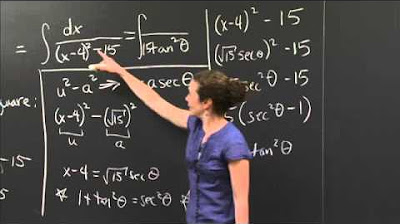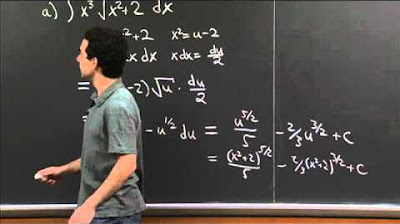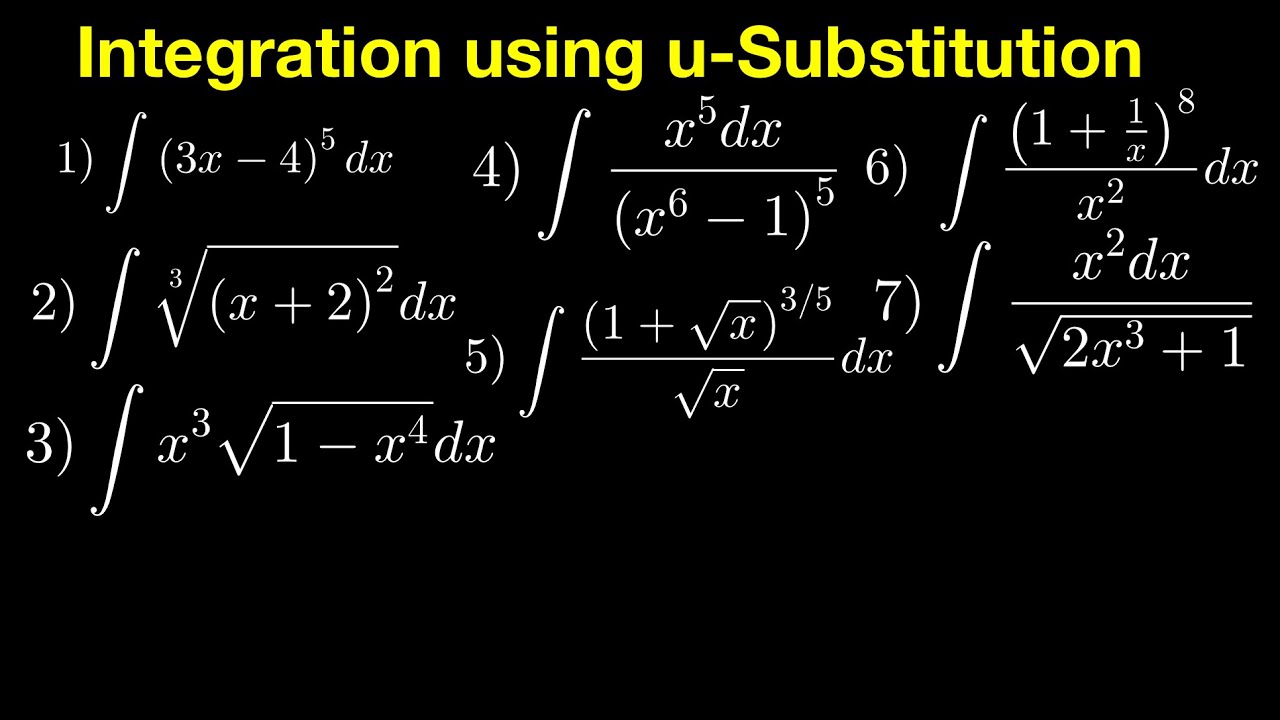Trigonometric Substitution
TLDRThis video tutorial explains the process of finding indefinite integrals using trigonometric substitution. It introduces three key forms for substitution and demonstrates the steps with two example problems. The first example involves the square root of a quadratic expression, while the second deals with a polynomial divided by a square root. The video guides through the substitution process, simplification, and the use of trigonometric identities to arrive at the final answers, effectively teaching viewers how to tackle complex integrals through this method.
Takeaways
- 📚 Trigonometric substitution is a method used to find the indefinite integral of certain functions.
- 🔍 Three key forms to recognize for trigonometric substitution are: √(a^2 - x^2), √(x^2 + a^2), and √(x^2 - a^2).
- 🧮 For √(a^2 - x^2), substitute x with a sine function, i.e., x = a * sin(θ), and dx becomes a * cos(θ) dθ.
- 📐 For √(x^2 + a^2), use the tangent substitution, i.e., x = a * tan(θ), and dx is a * sec^2(θ) dθ.
- 🌟 For √(x^2 - a^2), replace x with a secant function, i.e., x = a * sec(θ), and dx is a * sec(θ)tan(θ) dθ.
- 🔑 Example problem: To integrate √(4 - x^2) / x^2, recognize it as √(a^2 - x^2) with a = 2, and substitute x accordingly.
- 🧩 Simplify the integrand by using trigonometric identities, such as 1 - sin^2(θ) = cos^2(θ).
- 🌈 After integrating, convert back to the original variable (x) using the substitution relationships established earlier.
- 🛠️ Use SOHCAHTOA principles to find the missing sides of a right triangle and relate θ back to x.
- 🔄 For more complex integrals, consider further substitution, like u-substitution, to simplify the expression.
- 📈 The final answer should include the original variable (x) and a constant (c) representing the antiderivative.
Q & A
What is the main topic of the video?
-The main topic of the video is how to find the indefinite integral using trigonometric substitution.
What are the three forms that are important for trigonometric substitution?
-The three forms are: (1) the square root of a squared minus x squared, (2) a squared plus x squared inside a square root function, and (3) the square root of x squared minus a squared.
In the first form, what is the recommended substitution for x and why?
-In the first form, x should be substituted with a sine theta (where a is a constant) because 1 minus sine squared is cosine squared.
What substitution is used for x in the second form and what is the reason behind it?
-In the second form, x is replaced with a tangent theta because 1 plus tan squared is secant squared.
For the third form, what is the substitution for x and why is it used?
-In the third form, x is replaced with a secant theta because one secant squared minus one is tangent squared.
How does the video demonstrate the integration of the function (square root of four minus x squared) divided by x squared?
-The video demonstrates this by substituting x with 2 sine theta, performing algebraic simplifications, and eventually using the trigonometric identities and principles of SOHCAHTOA to find the integral.
What is the final result of the indefinite integral for the function (square root of four minus x squared) divided by x squared?
-The final result is negative arc sine (x divided by 2) plus c.
How does the video approach the integration of x cubed divided by the square root of x squared plus nine?
-The video approaches this by substituting x with 3 tangent theta, calculating dx, and then using trigonometric identities and u-substitution to find the integral.
What is the final result of the indefinite integral for the function x cubed divided by the square root of x squared plus nine?
-The final result is nine secant to the third power minus 27 times secant theta plus c.
What trigonometric identities are used in the process of solving the integrals in the video?
-The video uses identities such as 1 minus sine squared equals cosine squared, 1 plus tan squared equals secant squared, and the reciprocal identities like one over sine is cosecant, and one over sine squared is cosecant squared.
How does the video use the principles of SOHCAHTOA in the process of integration?
-The video uses the principles of SOHCAHTOA to create a right triangle and find the missing sides, which helps in converting the trigonometric expressions back to the x variable for the final answer.
Outlines
📚 Introduction to Trigonometric Substitution for Indefinite Integrals
This paragraph introduces the concept of finding the indefinite integral using trigonometric substitution. It outlines three key forms to be familiar with: the square root of a squared minus x squared, a squared plus x squared inside a square root function, and the square root of x squared minus a squared. The paragraph explains the substitution process for each form, detailing the use of sine, tangent, and secant functions with their corresponding identities. An example problem is introduced, setting the stage for the integration of a function with the form square root of four minus x squared, and guiding the viewer through the substitution process with x replaced by 2 sine theta.
🔍 Simplifying the Integration Process with Reciprocal Identities
In this paragraph, the video script delves into the simplification of the integration process using reciprocal identities. It explains how to handle the terms involving sine and cosine squared by using the identities for cosecant squared and secant squared. The paragraph demonstrates the steps to find the antiderivative of negative and positive cosecant squared, and how to convert the variable theta back to x using the principles of SOHCAHTOA. The example continues with the integration of x cubed divided by the square root of x squared plus nine, highlighting the use of tangent substitution and the calculation of dx. The paragraph concludes with the integral expressed in terms of secant and tangent theta.
🧮 Advanced Integration Techniques with U-Substitution
This paragraph focuses on advanced integration techniques, particularly u-substitution, to solve the integral of a trigonometric function. The example given involves the integration of 27 tangent cube secant theta. The script explains how to simplify the expression by replacing tangent cube with tangent theta times tangent squared theta and then introduces u-substitution with u as secant theta. The paragraph details the process of finding the antiderivative of u squared minus one and converting the expression back to terms involving secant and tangent theta. The final step involves simplifying the integral to a form involving secant to the third power and theta, and then converting theta back to an x variable using the initial substitution.
🎓 Finalizing the Integration and Variable Conversion
The final paragraph of the script wraps up the integration process by converting the expression from the previous paragraph back to x variables. It uses the initial substitution of x as three tangent theta and applies the principles of trigonometry and the Pythagorean theorem to find the missing side of the right triangle and evaluate secant and cosine theta. The paragraph demonstrates how to simplify the expression to a final answer involving x squared minus 18 plus c, providing a comprehensive conclusion to the process of finding the indefinite integral using trigonometric substitution.
Mindmap
Keywords
💡Indefinite Integral
💡Trigonometric Substitution
💡Square Root
💡Sine and Cosine
💡Tangent and Secant
💡Derivative
💡Algebraic Techniques
💡Reciprocal Identities
💡SOHCAHTOA
💡Pythagorean Theorem
💡Integration by Substitution
Highlights
The video discusses the method of finding the indefinite integral using trigonometric substitution.
Three forms are essential for trigonometric substitution: square root of a squared minus x squared, a squared plus x squared inside a square root function, and the square root of x squared minus a squared.
For the first form, x is substituted with a sine theta, because 1 minus sine squared is cosine squared.
In the second form, x is replaced with a tangent theta, as 1 plus tan squared is secant squared.
For the third form, x is substituted with a secant theta, since secant squared minus one is tangent squared.
An example problem is provided to demonstrate the integration of the square root of four minus x squared divided by x squared.
The video shows the step-by-step process of substituting x with 2 sine theta and simplifying the integral expression.
The algebraic techniques used to simplify the expression and the use of trigonometric identities are explained.
The antiderivative of cosecant squared is cotangent, and the antiderivative of negative cosecant squared is negative cotangent.
The process of converting the variable theta back to x using the principles of sohcahtoa is detailed.
Another example is provided for finding the integral of x cubed divided by the square root of x squared plus nine.
The video demonstrates the use of u substitution to simplify the integral expression involving tangent and secant functions.
The final answer for the second example is derived by converting back to the original variable x.
The video emphasizes the importance of understanding trigonometric identities and the Pythagorean theorem in solving these integrals.
The method showcased in the video is particularly useful for solving integrals of functions with trigonometric and algebraic components.
The video provides a comprehensive guide to applying trigonometric substitution for finding indefinite integrals.
Transcripts
Browse More Related Video

Integrals: Trig Substitution 3 (long problem)

Lesson 16- Integration By Trig Substitution (Calculus 1 Tutor)

Integration by completing the square | MIT 18.01SC Single Variable Calculus, Fall 2010

Integration Practice III | MIT 18.01SC Single Variable Calculus, Fall 2010

Calculating integral disc around vertical line | AP Calculus AB | Khan Academy

Integration Using u-Substitution
5.0 / 5 (0 votes)
Thanks for rating: